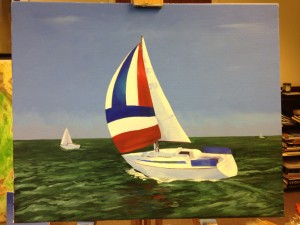|
 Today’s work on the Allegro was mostly making good on my promises from last time. I had solved most of the problems by the end of day 3, in that I knew where the boat was, what colour the sea was, and what shapes most things were. However, I had to go over the detail on the boat. I’d been struggling to see what was where based on my source photo, and at the same time I had had to work out the lighting, so this time I already had the lighting set out before me, and I could move details about. The hull and the superstructure both needed a bit of work, so I made a list of all the items and did them, top to bottom. Some of them solved the later ones, such as the extra height needed on the sunlit patch close to us, and the edge of the boat needing to bulge a little and come further down. Others needed me to repaint the sea, which I was not intending to do, but did manage to fit in. The superstructure occluded a lot of the starboard edge, making it difficult to see what is going on, and that needed attention. I also shaped the boats in the background. Today’s work on the Allegro was mostly making good on my promises from last time. I had solved most of the problems by the end of day 3, in that I knew where the boat was, what colour the sea was, and what shapes most things were. However, I had to go over the detail on the boat. I’d been struggling to see what was where based on my source photo, and at the same time I had had to work out the lighting, so this time I already had the lighting set out before me, and I could move details about. The hull and the superstructure both needed a bit of work, so I made a list of all the items and did them, top to bottom. Some of them solved the later ones, such as the extra height needed on the sunlit patch close to us, and the edge of the boat needing to bulge a little and come further down. Others needed me to repaint the sea, which I was not intending to do, but did manage to fit in. The superstructure occluded a lot of the starboard edge, making it difficult to see what is going on, and that needed attention. I also shaped the boats in the background.
 Now, here’s an interesting thing. With the exception of a bit of the sea bottom right, these pictures are the same, taken with the same camera. The difference is in the lighting. Sodium lighting picks out yellow colours, as it’s largely a hot, yellow light. Halogens, LEDs of different varieties, and incandescent bulbs all have different colour properties. This is a fantastic example of why I try to paint under natural light. It gives me the best chance of painting something that will look good under a client’s lighting system, whatever that is. Now, here’s an interesting thing. With the exception of a bit of the sea bottom right, these pictures are the same, taken with the same camera. The difference is in the lighting. Sodium lighting picks out yellow colours, as it’s largely a hot, yellow light. Halogens, LEDs of different varieties, and incandescent bulbs all have different colour properties. This is a fantastic example of why I try to paint under natural light. It gives me the best chance of painting something that will look good under a client’s lighting system, whatever that is.
Our eyes will make up for the lighting in a way that a camera cannot, by taking into account relative shifts in light as well as absolute ones. The side effect of that ability is that when I was looking at the sail as I painted it, I was slowly creating a negative on my retina. The red and blue cones were being triggered often enough that when I looked back down at my palette, I had colours superimposed on the paint I was using, until my retina recovered. As you can see here, the boat pops out and is really warm, so it was worth turning the lights on just to see that.
|